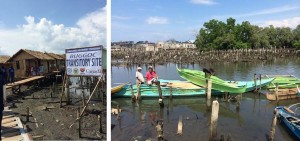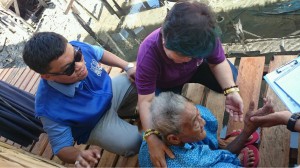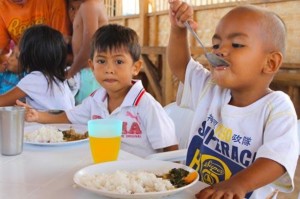
Zamboanga City – One year after the armed conflict between the military and the Moro National Liberation Front (MNLF)-Misuari faction here, new communities have risen in various areas established by the government as transitional and permanent resettlement sites for families who lost their homes.
In Barangay Tulungatong, a transitional site, for instance, where 412 families have already transferred, is now a busy community. Around 25 bunkhouses with 300 rooms were built here by the Department of Social Welfare and Development (DSWD) and partners.
Internally displaced Sama-Badjaos who used to occupy the Cawa-Cawa Boulevard are now in transitional and permanent shelters, re-establishing their community.
Now, the area is free from family-evacuees and the local government unit (LGU) is cleaning up the area.

In Buggoc, 54 families have recently transferred to the single-detached transitional houses. More families are expected to transfer upon completion of some 163 units by October 2014.
Rogelio Olbido’s family was among the first to call the shelter in the area, their new home.
Rogelio, 72, said “Nasa ligtas na bahay na po kami (We are now in a safe house).”
DSWD said that around 1,906 families have transferred to transitional shelters/bunkhouses which are now serving as temporary homes to the displaced families while waiting for their permanent houses.
Rising from the ravages of conflict, the internally displaced persons (IDPs) have transformed these empty sites into a thriving community, showcasing rows of homes with neat, small gardens planted with vegetables, flowers and ornamental plants; sari-sari stores, children playing, families doing their laundry or going about their household chores, and neighbors chatting animatedly.
With the help of the government and partner humanitarian organizations, the survivors of the siege have found renewed hope in these transitional sites.
Some permanent shelters have already been constructed, such as the Martha Permanent Shelter, now with 44 families
Teresa Maru, shared “Masaya na ang buhay naming dito sa Martha shelter (We are happy here at the Martha permanent shelter).”
This was affirmed by Lilia Fuentebella, 74. “Salamat sa pabahay na ito na tulong ng gobyerno. Nabago po ang buhay namin (Thanks to this housing provided by government, our lives have changed).”
DSWD Secretary Corazon Juliano-Soliman said that all displaced families, especially those still living in the Zamboanga Grandstand, will be transferred to safer homes by year end.
“The goal is to close all evacuation centers and move all families to shelters. Our target is that by December 15, the Grandstand will be empty as the families there will have already been given temporary or permanent shelters,” she pointed out.
The Secretary however calls for a ” real durable solution” to the problem.
“While we have shelter as the temporary answer to the problem of internal displacement, the real durable solution to all this is peace in Zamboanga and in the country,” Sec. Soliman explained.
Response
The course of the armed conflict affected a total of 23,794 families in 14 barangays such as Arena Blanco, Cabatangan, Calarian, Canelar, Kasanyangan, Mampang, Mariki, Rio Hondo, San Roque, Sta. Barbara, Sta Catalina, Talon-Talon, and Zone IV.
Massive destruction was recorded in eight out of the 14 barangays, which were the location of the actual conflict.
These were Arena Blanco, Kasanyangan, Mampang, Mariki, Rio Hondo, Barbara, Sta. Catalina and Talon-Talon.
More than 20,000 families were displaced due to the prolonged fighting which left 10,160 houses totally destroyed. The massive destruction of properties and businesses created a setback in the entire socioeconomic status of the Zamboangueños.
As soon as the armed conflict ensued, the local government led by Mayor Beng Climaco and the national government wasted no time in responding to the urgent needs of the affected families.

Evacuation centers were immediately established to accommodate the displaced families. DSWD provided food assistance to the most vulnerable displaced families, including psycho-social interventions.
Based on the record, DSWD provided a total of 553,120 food packs to evacuees which amounted to more than P264 million.
Likewise, the Department provided non-food items such as mats, malong, hygiene kits which cost P7,696,558.50
Recognizing the needs of the IDPs for livelihood, DSWD also implemented the cash-for-work program which benefited 466 individuals amounting to P3.8 million for two-months-worth of work.
In partnership with DSWD, the World Food Programme (WFP) also provided food-for-work, distributing to 18,000 IDPs a total of 18,000 bags of rice to amounting to P22.5 million.
To address the psycho-social needs of the evacuees especially the children, DSWD conducted counseling, and art and play therapy sessions. Stress debriefing was also conducted to IDPs in evacuation centers.
Road to recovery
With “Build Back Better Zamboanga” as the working goal, the national government, the LGU, and civil society organizations continued to converge their services to achieve this.
Sec. Soliman said that the way to recovery is to enable the IDPs to regain their productive capacity.
Providing an opportunity to earn is also a key component towards rebuilding the IDP’s lives, the Department strengthened its livelihood program for the affected families.
Not far away from the Buggoc Transitory shelter where the Sama-Badjaos have transferred, they are now seen fixing things in their boats ready to go out into the sea to catch fish.
Likewise, DSWD provided 2,483 families with livelihood assistance amounting to P20,173,880 to start their own sources of livelihood.
Complementing the livelihood assistance are DSWD’s other programs and services for the IDPs such as the Pantawid Pamilyang Pilipino Program, Sustainable Livelihood Program, Supplementary Feeding Program, and Social Pension for Indigent Senior Citizens, among others.
Sec. Soliman is confident that with the continued convergence of services, building back a better Zamboanga is not far behind, prompting her to express her dream for the city.
“My vision for the city is the Vinta – colorful and sailing away to a brighter future in Zamboanga.” ###


